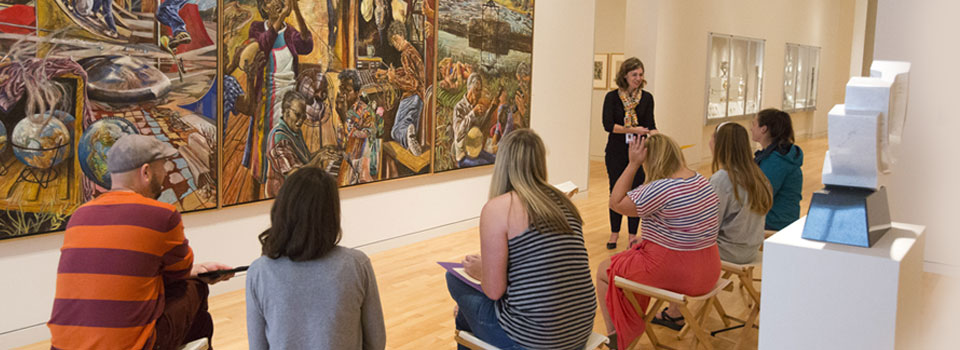Lecturing students is a common practice for a university professor to do in a classroom. However, Carissa DiCindio, curator of education at the Georgia Museum of Art, rejects the practice of lecturing-and the traditional classroom setting.
DiCindio, who teaches a unique special topics and service-learning course called “Engaging Art Museum Audiences as Student Docents,” believes that in order for her students to truly gain a comprehensive understanding of the subject, they need to experience the process of museum tours firsthand. Students begin the course by shadowing a museum tour, reflecting on how the leading docent engages the audience and facilitates discussion around the artwork. This observation period is followed by students taking those skills and applying them to their own tours.
“In order for them to really learn, I tell (students) that they have to jump in. It’s a risk to put yourself out there like that, and sometimes fail-I do, too. You try things, and some things work and some things don’t. I think the more tools that I can give them to approach problems the better. It’s all about confidence, and the only way to build that confidence is to keep doing it. I want them to love it, I really do. I want them to have fun with it, too,” says DiCindio.
The course, which is held in GMOA galleries as frequently as possible, focuses less on art history and more on art as a dynamic subject. Because there is no clear-cut way to interpret a piece of art, leading a tour is less about informing the audience as it is enabling people to respond to the piece. DiCindio focuses on helping students find ways to facilitate dialogues between visitors and docents. The main goal is for visitors to interact and engage with the art.
“Every time you approach a work of art, it’s going to be a little bit different because you’re different, your experiences are changing who you are and you’re learning new things. You can approach a work of art over and over again and make different connections. There is no guidebook that says ‘this is what this means.’ It’s about how we interpret it. I think that’s really important for everyone to understand, but especially for people who don’t have a lot of experience with interpretation or art history. Everyone has something to offer,” says DiCindio.
Aside from leading tours, the class also participates in a service-learning experience in order to gain perspective on the ways tours can give back to the community. In fall 2013, the students created a program called “Creating Memories and Sharing Stories: The Art of Carroll Cloar.” In an effort to engage visitors, the event invited grandparents and grandchildren to explore the work of Cloar together, as well as create artwork of their own using similar techniques. Participants were encouraged to use symbols to tell stories about their family. The project attempts to reflect the goals of creating an active audience and personal experiences.
The final element of the course is for the students to design their own tour, incorporating the research done throughout the semester. Some tours, like Museum Mysteries, which was held over the summer of 2013, continue to be given after the students complete their credit hours.
“It’s not just an art history class, and I think students from other areas would really benefit from the course. There are so many different ways that you can interact with a work of art, so the more voices and perspectives we have, the better,” says DiCindio.


